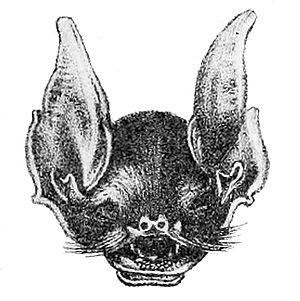Macleay's mustached bat facts for kids
Macleay's mustached bat (Pteronotus macleayii) is a small bat species. It lives in Cuba and Jamaica. This bat is named after William Sharp Macleay, who first collected a sample of it. Sadly, its homes are shrinking, which puts the bat at risk.
Quick facts for kids Macleay's mustached bat |
|
|---|---|
 |
|
| Conservation status | |
| Scientific classification | |
| Genus: |
Pteronotus
|
| Species: |
macleayii
|
| Subspecies | |
|
P. m. macleayii |
|
| Synonyms | |
|
Chilonycteris macleayii |
|
Contents
What Macleay's Mustached Bat Looks Like
Macleay's mustached bat is a very small bat. Its body is about 7.4 centimeters (about 3 inches) long. Its tail is about 2.3 centimeters (less than an inch) long. Adult bats weigh between 4 and 7 grams, which is about as much as a few paperclips. Male bats are usually a little bigger than females.
Their fur can be grayish-brown or orange-brown. It gets lighter on their belly, almost white. Their head is quite flat, and their nose points slightly upwards. They have narrow, pointy ears. The edges of their ears are a bit jagged near the tips. They also have a long, flat piece of skin in their ear called a tragus.
Their wings are shaped for flying easily through thick forests. This helps them move quickly among trees and plants.
Where Macleay's Mustached Bat Lives
Macleay's mustached bats are found all over Cuba and Jamaica. They live wherever they can find suitable caves. These caves are important for them to rest and raise their young.
There are two main types, or subspecies, of Macleay's mustached bat:
- Pteronotus macleayii macleayii – This type lives in Cuba and on the Isla de la Juventud.
- Pteronotus macleayii griseus – This type lives in Jamaica.
Life and Habits of the Bat
Macleay's mustached bats are very social animals. They live in large groups, called colonies. These colonies can have thousands of bats! During the day, they rest in deep, damp cave systems. They often share these caves with other bat species. However, they usually stay close to other Macleay's mustached bats.
These bats are nocturnal, meaning they are active at night. They leave their caves shortly after the sun sets. They spend the night hunting for insects to eat. Their favorite foods are flies and beetles.
Macleay's mustached bats use special sounds to find their way and catch food. This is called echolocation. They make short, high-pitched calls that bounce off objects. This helps them "see" in the dark.
Reproduction and Life Cycle
Breeding for these bats starts around March. The female bats usually give birth to one baby bat. This happens between June and July.
See also
 In Spanish: Pteronotus macleayii para niños
In Spanish: Pteronotus macleayii para niños


